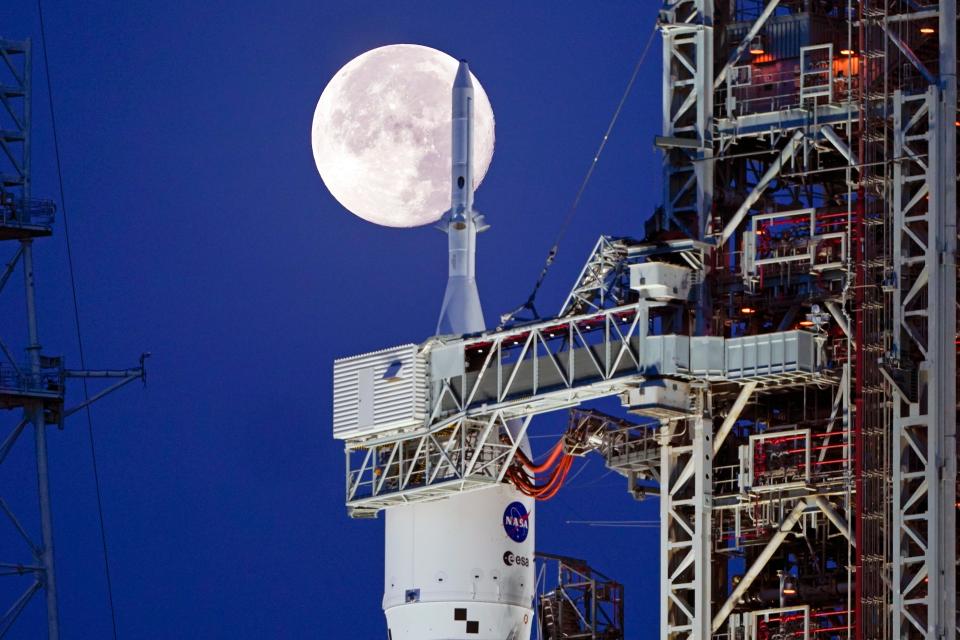The Artemis mission to the moon
- Oops!Something went wrong.Please try again later.
Looming about 250,000 miles away, the moon is our natural satellite. A familiar face in the night sky, it remains the only celestial body visited by humans. In July 20, 1969, Commander Neil Armstrong and module pilot Buzz Aldrin stepped on the surface, and spent three days collecting nearly 50 pounds of lunar material, while the pilot Michael Collins flew the Command Module Columbia in lunar orbit.
That was the historic Apollo 11 mission, watched live by millions of people gleaming with awe and pride. Other five crewed missions were completed after Apollo 11, but the Apollo 17 mission of December 1972 marked the last time human beings walked on the moon. We have not returned in 50 years. Instead of the dawn of a new age of navigation, the moon landing looks more like us testing the water of the ocean, finding it too cold, and quickly retreating back to the safety of land.
The Apollo program cannot be dissociated from its context in the Space Race and the Cold War. The goal was to one-up the Soviet Union, who was scoring a series of firsts — first satellite in orbit, first animal in orbit, first probe on the moon, first man in space, first woman in space, first spacewalk; every first a demonstration of Soviet technological superiority. The moon landing was the crown jewel that swayed public perception toward American preeminence. The goal was never to understand the origin of the moon, or its geological intricacies. It was a political race to climb a mountain. Once done, there was no strong reason to go back. In a way, the 1969 moon landing was a 21st century idea that somehow made it to the 20th.

It is thus with excitement that we welcome NASA’s planned Artemis mission. Artemis, in Roman-Greek mythology, is Apollo’s twin sister. An apt name for a return to the moon. In removing the political coating, we are going back to the moon for the right reasons. The Earth and the moon are at the same distance from the sun, but without atmosphere or geological activity, the surface of the moon, unlike Earth’s, does not experience erosion. The moon has recorded 4 billion years of impacts and space weather, a record of the conditions that the Earth-moon system experienced during its evolution since formation. For the astronomer, the moon works as a registry book.
Artemis' current science objectives are to understand the character and origin of lunar polar ice, interpret the history of impacts that the Earth and the moon experienced, and reveal how the young sun and our place in space looked like in the distant past. Artemis has an ambitious program, with five planned flights, the first one scheduled for this year. While Artemis I does not have a crew, the subsequent flights will be crewed. The excitement peak will be reached in 2025, with Artemis III, a crewed lunar landing. Unlike Apollo’s lunar module, Artemis will make use of a much more sophisticated human landing system. Placed in orbit around the moon, the human landing system will function like an elevator to carry a crew to the lunar surface, and later return them to orbit for safe return to Earth.
Also unlike Apollo, Artemis will develop a habitat on the lunar surface, housing equipment for surface activities including moonwalks, sample collection and scientific experiments. After Artemis III, each landing will take advantage of increasing amounts of infrastructure landed by previous missions. Artemis will work toward building a basecamp on the moon. NASA Artemis Basecamp will be a sustainable infrastructure on the moon, which will include rovers that will expand exploration area, and provide autonomous or remote operations when crew is not on the surface.

Can Basecamp become the first city on the moon? Hard to say, but probably not. The 2017 award-winning novel by Andy Weir, also called Artemis, describes a city on the moon in the late 2080s, around the Apollo landing site in the Sea of Tranquility. The timeline — barely 60 years away — is probably much too short. And we are much too tied to the narrative of colonialism, where European cities were erected in the New World and Australia following “discovery.” The moon is not the Americas. The moon is not Australia. There’s no living off the land.
Most likely, Basecamp will be like the stations in Antarctica today — a scientific outpost and temporary home to a rotating crew. Astronauts may stay several months at a time, becoming increasingly more comfortable with the lunar environment, and refining the technologies of space dwelling. From their vantage point on the surface of the moon, they’ll glance at both Earth and stars, and perhaps they’ll have the feeling that they’re in the middle between them. The moon is the offshore island where we hone our navigation skills before sailing into open ocean. Artemis Basecamp may become our bridge to the stars.
More Star News:
lhuiyolitzin Villicana Pedraza, PhD., is a molecular spectroscopy specialist and on the astronomy and physics faculty at Doña Ana Community College and New Mexico State University. Wladimir Lyra is an associate professor of astronomy at New Mexico State University. He can be reached at wlyra@nmsu.edu or @DrRRLyrae on Twitter.
This article originally appeared on Las Cruces Sun-News: The Artemis mission to the moon

